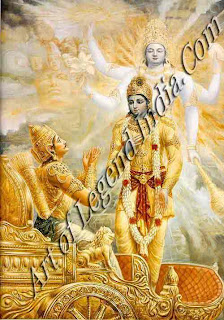 The Epics
The Epics
However,
since the ordinary people do not have the erudition to read and understand
these books, there are a third set of books, the Itihasas or Epics, which serve
the purpose. The profound philosophy of the Upanishads is presented in the form
of parables and stories in these epics for the guidance of the common people.
The
great epics of Hinduism are the Ramayana, the Mahabharata, the Yogavasishta and
the Harivamsa. They are also called the Suhrit Samhitas or friendly
compositions, as they teach the greatest of truths in an easy, friendly way
without taxing the mind, as the language is simple and the contents easily
understood.
Of
these the Ramayana and the Mahabharata are known even to the most illiterate of
Hindus as they have come down through the ages by word of mouth. They teach the
ideals of Hinduism in a most understandable form and it is because of these
books that the most illiterate of our peasants is not ignorant. On the other
hand he carries within him the wisdom of the Upanishads which has been conveyed
to him by these two major epics in story, ballad or dance form.
The
more popular of these two epics is the Ramayana. Also known as the Adi Kavya or
the first poetic composition of the world, it was written by the great sage,
Rishi Valmiki. In this epic is given the story of Rama, believed to be an
incarnation of Lord Vishnu, born on earth to show the path of righteousness.
 Dasaratha,
king of Ayodhya, had four sons, Rama, born of his first queen, Kausalya.
Lakshmana and Shatrughna, born of his second queen, Sumitra and Bharata, born
of his favourite queen, Kaikeyi.
Dasaratha,
king of Ayodhya, had four sons, Rama, born of his first queen, Kausalya.
Lakshmana and Shatrughna, born of his second queen, Sumitra and Bharata, born
of his favourite queen, Kaikeyi.
Rama
was banished to the forest for 14 years at the behest of his step-mother,
Kaikeyi, and left with his wife, Seeta, and brother, Lakshmana. In the forest
Seeta was abducted by the demon-king, Ravana of Lanka. Rama, helped by an army
of monkeys, and by Hanuman, the most loyal of them all, fought and destroyed
Ravana and brought back Seeta. He was then crowned king and ruled over Ayodhya.
Rama
Rajya, the reign of Rama, was one of idealism and 12 perfection, when no tear
was shed nor sorrow experienced. It was a time of peace and joy, an idyllic era
for all good people. Ayodhya became a land where tolerance and understanding
governed the actions of everyone and even the King's actions were subject to
the will of the people. Ideal behaviour of the rulers and ruled, of men and
women, were shown by the actions of the characters in this epic, thereby
teaching the people, subtly yet effectively, what ideal behaviour should be.
For
example, to show the qualities of ideal queens, we have Dasaratha's queens,
Kausalya and Sumitra, soft-spoken but strong, who placed the prestige of the
king and the kingdom above their love of their sons. Dasaratha had earlier
given two boons to Kaikeyi and she asked that Rama be sent to the forest for 14
years and her own son, Bharata, be crowned king. Rama, the ideal son, readily
agreed to go and Lakshmana accompanied him. Their mothers, Kausalya and
Sumitra, sent away their beloved sons to the forest so that king Dasaratha
could keep his word. A second lesson learnt from this was the importance of the
spoken word, especially the promises made by a ruler.
Also,
the sacrifices of which Hindu women were capable were depicted by several such
instances.
To
delineate the qualities of a high-principled man, we have Bharata who, on his
return from a visit to his uncle, found his brother banished to the forest by
his mother and the kingdom his to be ruled, as his father had died of grief
meanwhile. However he would not take over as king and, when Rama refused to
come back till all 14 years of exile promised by him to his late father and
step-mother were over, Bharata took his brother's paduka or wooden slippers,
placed them on the throne and ruled as regent till his brother's return.
The
qualities of the ideal man, prince and king are learnt by the ordinary people
to this day from the character of Rama, of the ideal woman and wife from the
strong but gentle character embodied in Seeta, and of the qualities of ideal
brothers from the behaviour of Bharata, Lakshmana and Shatrughna.
The
ideal qualities of loyalty, unstinted devotion and love are depicted in the
character of Hanuman, the monkey, who helped Rama cross over to Lanka and
defeat Ravana. When Lakshmana was hit by a poison arrow and needed medicinal
herbs from the Oshadhi Mountain in the Himalayas, Hanuman flew north all the
way but found, on reaching there, that he could not identify the particular
herb asked for. Knowing that his beloved Rama may not live if Lakshmana was not
revived, he lifted the whole mountain and carried it all the way back to Lanka.
The
potential for good and evil in all beings is brought out again and again. The
destruction of evil by good either by oneself or by divine intervention is a
constant theme of Hinduism.
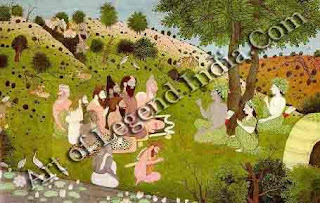 Even
the demons were not all bad and wicked and are shown as having good qualities
also. Ravana, the demon-king of Lanka, was a great scholar. Even though he
abducted Seeta to make her his queen, he treated her with respect and regard
and never molested or harmed her but awaited her consent to marry her. Hanuman,
in his attempt to locate Seeta, visits Lanka, and is greatly struck by Ravana
and says, "What courage! What strength! What a combination of great
qualities is Ravana!"
Even
the demons were not all bad and wicked and are shown as having good qualities
also. Ravana, the demon-king of Lanka, was a great scholar. Even though he
abducted Seeta to make her his queen, he treated her with respect and regard
and never molested or harmed her but awaited her consent to marry her. Hanuman,
in his attempt to locate Seeta, visits Lanka, and is greatly struck by Ravana
and says, "What courage! What strength! What a combination of great
qualities is Ravana!"
Ravana's
brother, the demon Kumbhakarna, disapproved strongly of the abduction of Seeta.
Yet because he had prospered under Ravana's patronage, and "eaten his
salt", he refused to desert his brother in his hour of peril.
The
great virtue of loyalty, even for a lost cause, was brought out by such
instances.
Through
the stories from the Ramayana which are recited to them, the ordinary people
learn the difference between right and wrong, develop a high sense of values
and understand what ideal behaviour is. The tremendous cultural heritage of the
Vedas and Upanishads has reached and permeated to the most illiterate of our
people through Sage Valmiki's priceless epic, the Ramayana. This is why our
peasants, even those living in remote villages, know to this day what they can
expect from the laws of the land and are not ignorant of their rights nor of
what is due to the ruled by the rulers. The illiterate peasant trusts his
rulers implicitly, expecting another Rama Rajya, and today uses the modern tool
of the vote to express his feelings towards his rulers. The illiterate villager
is therefore not ignorant as the city educated think him to be.
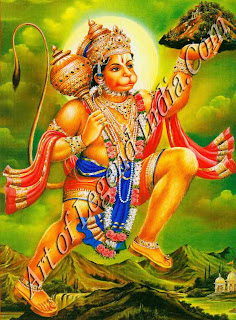 The
second great epic of the Hindus, the Mahabharata, was compiled by Sage Vyasa
and revolves around the Great War between two princely families, the righteous
five Pandava brothers and their evil cousins, the hundred Kauravas. The central
character of the epic is Lord Krishna, an incarnation of Vishnu on earth, a man
of action and statesman.
The
second great epic of the Hindus, the Mahabharata, was compiled by Sage Vyasa
and revolves around the Great War between two princely families, the righteous
five Pandava brothers and their evil cousins, the hundred Kauravas. The central
character of the epic is Lord Krishna, an incarnation of Vishnu on earth, a man
of action and statesman.
When
poised on the battlefield ready for battle, Arjuna, the great warrior and one
of the Pandava brothers, sees that the enemies that are arrayed before him are
his close relations, cousins, uncles and grand-uncles, and refuses to fight or
destroy them. Krishna, who acts as his charioteer, advises him on the
importance of his dharma or duty as a warrior to fight for righteousness. The
Kauravas, representing evil, have to be destroyed to restore Dharma or
righteousness in the land.
Swami
Vivekananda compares the Kurukshetra battlefield to the world we live in. The
five Pandava brothers represent righteousness and the hundred Kauravas the
myriad worldly attachments we have to fight against. Arjuna, the soul awakened
by the teachings of Krishna, is the general who leads in this battle.
The
teachings of Lord Krishna called the Bhagavad Gita, or the Song of the Lord,
are part of the discourse between Lord Krishna and Arjuna at Kurukshetra during
the great Mahabharata War. In this priceless scripture, Lord Krishna places
emphasis on Nishkama Karma or action without desire or passion and without any
worry about the fruits or results of one's actions. Through such scriptures the
duties of the ideal man were laid down, showing him to be a Yogi, or one
unattached to worldly desires, as far as his heart and mind are concerned, but
also as a man of action setting right the wrongs of society.
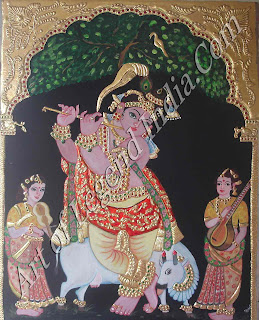 An
interesting allegory is the comparison of the Upanishads to a cow, the Bhagavad
Gita to milk, Krishna to a cowherd and Arjuna to a calf. In other words, the
essence of the Upanishads is milked by Krishna and the milk, the Bhagavad Gita,
fed to Ariuna.
An
interesting allegory is the comparison of the Upanishads to a cow, the Bhagavad
Gita to milk, Krishna to a cowherd and Arjuna to a calf. In other words, the
essence of the Upanishads is milked by Krishna and the milk, the Bhagavad Gita,
fed to Ariuna.
The
Shantiparva of the Mahabharata contains the teachings of Bhishma Pitamaha, the
grand-uncle of the family from which were descended both the Pandavas and the
Kauravas. These words of wisdom were uttered while Bhishma was awaiting his
death after being seriously wounded in the Great War. In his discourse, Bhishma
instructs Yudhishtira, the oldest Pandava brother, on Dharma or righteous
conduct and duty, on statecraft and the responsibilities of a ruler. These
teachings on Hindu Dharma are without parallel.
From
the Mahabharata, therefore, the people learnt the rules and the codes of ideal
conduct laid down for man and woman, king and commoner.
Writer –
Shakunthala Jagannathan
 The Epics
The Epics  Dasaratha,
king of Ayodhya, had four sons, Rama, born of his first queen, Kausalya.
Lakshmana and Shatrughna, born of his second queen, Sumitra and Bharata, born
of his favourite queen, Kaikeyi.
Dasaratha,
king of Ayodhya, had four sons, Rama, born of his first queen, Kausalya.
Lakshmana and Shatrughna, born of his second queen, Sumitra and Bharata, born
of his favourite queen, Kaikeyi.  Even
the demons were not all bad and wicked and are shown as having good qualities
also. Ravana, the demon-king of Lanka, was a great scholar. Even though he
abducted Seeta to make her his queen, he treated her with respect and regard
and never molested or harmed her but awaited her consent to marry her. Hanuman,
in his attempt to locate Seeta, visits Lanka, and is greatly struck by Ravana
and says, "What courage! What strength! What a combination of great
qualities is Ravana!"
Even
the demons were not all bad and wicked and are shown as having good qualities
also. Ravana, the demon-king of Lanka, was a great scholar. Even though he
abducted Seeta to make her his queen, he treated her with respect and regard
and never molested or harmed her but awaited her consent to marry her. Hanuman,
in his attempt to locate Seeta, visits Lanka, and is greatly struck by Ravana
and says, "What courage! What strength! What a combination of great
qualities is Ravana!"  The
second great epic of the Hindus, the Mahabharata, was compiled by Sage Vyasa
and revolves around the Great War between two princely families, the righteous
five Pandava brothers and their evil cousins, the hundred Kauravas. The central
character of the epic is Lord Krishna, an incarnation of Vishnu on earth, a man
of action and statesman.
The
second great epic of the Hindus, the Mahabharata, was compiled by Sage Vyasa
and revolves around the Great War between two princely families, the righteous
five Pandava brothers and their evil cousins, the hundred Kauravas. The central
character of the epic is Lord Krishna, an incarnation of Vishnu on earth, a man
of action and statesman.  An
interesting allegory is the comparison of the Upanishads to a cow, the Bhagavad
Gita to milk, Krishna to a cowherd and Arjuna to a calf. In other words, the
essence of the Upanishads is milked by Krishna and the milk, the Bhagavad Gita,
fed to Ariuna.
An
interesting allegory is the comparison of the Upanishads to a cow, the Bhagavad
Gita to milk, Krishna to a cowherd and Arjuna to a calf. In other words, the
essence of the Upanishads is milked by Krishna and the milk, the Bhagavad Gita,
fed to Ariuna. 
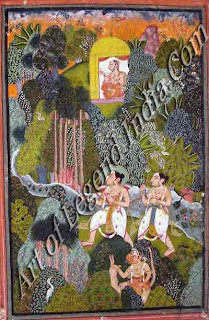










0 Response to "The Epics of Hinduism - Mahabharata"
Post a Comment